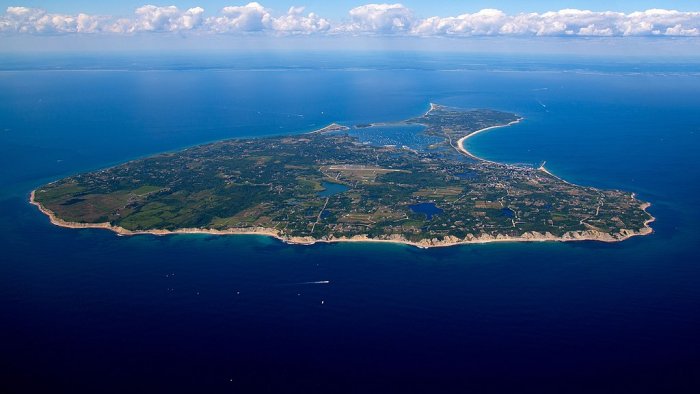Palatine Light Legend Is Based On A True And Tragic Event – What Really Happened On Block Island
Ellen Lloyd - AncientPages.com - Every year, sometime between Christmas and New Year's Eve, residents of Block Island, Rhode report seeing an eerie light that is believed to be the apparition of a ghost ship named Palatine. The mysterious light has haunted the island for centuries.
Dr. Aaron C. Willey, a Block Island resident, said that people were so used to the light that it was not mentioned often.
Locals still hear the cries from the dead on Block Island. Credit: Public Domain
"The people who have always lived here are so familiarized to the sight that they never think of giving notice to those who do not happen to be present, or even of mentioning it afterward. The light looks like a blaze of fire six or seven miles from the northern part of Block Island.
Sometimes it's small, like the light from a distant window. Sometimes it's as big as a ship and wavers like a torch," Dr. Willey, who saw the light in 1810, recalled.
The Horrible Fate Of Princess Augusta
The legend of the Palatine light is based on true and sad events. It is a tragic story, and there are several versions of what may have led to this tragedy. Some circumstances are unclear and very disturbing.
In August 1738, the 220-ton British ship Princess Augusta left Rotterdam, Netherlands. Under the command of Captain George Long and 14 crew members, the ship was carrying 240 immigrants who were on their way to English colonies in America.
The passengers were German Palatines, early 18th-century emigrants from the Middle Rhine region of the Holy Roman Empire, and the destination was Philadelphia.
It was a doomed voyage, and their fate was not to reach the New World alive. The ship carried contaminated water that caused a "fever and flux", resulting in that Captain George Long, half of the crew, and 200 passengers died.
First Mate Andrew Brook took over the command, but the situation on Princess Augusta was desperate and offered faint hope of survival. Food was running out, and Brook had no choice but to charge passengers for the remaining rations. As if the contaminated water wasn't enough, Princess Augusta was also pushed by severe storms, and the few survivors had to struggle to remain alive while enduring extreme weather conditions.
Princess Augusta managed to stay afloat for three months. Then, on December 27, 1738, Princess Augusta wrecked at Sandy Point on Block Island during a snowstorm.
Were Residents Of Block Island Guilty Of A Crime?
What transpired next is not entirely clear. It is also unknown what happened to the wreck. According to some accounts, the ship was set on fire. Another possibility is that it was pushed out to sea to sink.
Depositions taken from the surviving crew, discovered in 1925, reveal that Brook and his crew got into the ship's longboat and rowed ashore, leaving the passengers behind. When Brook reached Block Island, he was convinced by locals to retrieve the passengers. Locals buried those who had died in the catastrophe. The few survivors were taken to peoples' homes and nourished back to health.
Block Island looking North over Block Island Sound. The coast of Rhode Island is seen in the distance. Credit: Timothy J. Quill, Public Domain, CC BY-SA 4.0
There have also been claims that residents of Block Island were not so friendly at all. Joseph Peace Hazard (1807-1892), considered himself clairvoyant and wrote in his letter to poet John Greenleaf Whittier.
That Block Islands residents deliberately lured the ship onto the shoals with a false light. Hazard accused locals of murdering the poor, starving, freezing passengers, and stealing their possessions. Whether or not the people living on Block Island were guilty of this horrible crime is unknown. What is certain is that the Block Island Historical Society raised a memorial marker in honor and memory of the 20 passengers who had died and were buried on the island.
According to legends, one woman, Mary Vanderline, who had gone mad, refused to leave the ship during the rescue mission. As a result, she died, and it is her horrifying screams residents of Block Island hear every year.
The memory of the ghost ship was kept alive by John Greenleaf Whittier, who in 1867 wrote a poem called The Wreck of the Palatine:
"And then, with ghostly shimmer and shine
Over the rocks and the seething brine,
They burned the wreck of the Palatine.
In their cruel hearts, as they homeward sped,
'The sea and the rocks are dumb,' they said.
'There'll be no reckoning with the dead.'"
As far as it is known, Brook and his crew were not found guilty of any crime and didn't suffer any punishment. However, Block Island has a marker on the spot where the ship is thought to have run aground. It reads - Palatine Graves – 1738.
Written by Ellen Lloyd – AncientPages.com
Updated on September 15, 2022
Copyright © AncientPages.com All rights reserved. This material may not be published, broadcast, rewritten or redistributed in whole or part without the express written permission of AncientPages.com
Expand for referencesMore From Ancient Pages
-
 Unorthodox Ancient ‘Out-Of-This World’ Carvings Were Found And Destroyed – Mysterious Labyrinth And Unknown Ruins – Part 2
Featured Stories | Aug 13, 2020
Unorthodox Ancient ‘Out-Of-This World’ Carvings Were Found And Destroyed – Mysterious Labyrinth And Unknown Ruins – Part 2
Featured Stories | Aug 13, 2020 -
 New Fossil Of 145-Million-Year-Old Pterosaur Nicknamed Elvis
Fossils | Jul 14, 2023
New Fossil Of 145-Million-Year-Old Pterosaur Nicknamed Elvis
Fossils | Jul 14, 2023 -
 On This Day In History: Pakal Ascends The Throne Of Palenque At Age Of 12 – On July 29, 615
News | Jul 29, 2016
On This Day In History: Pakal Ascends The Throne Of Palenque At Age Of 12 – On July 29, 615
News | Jul 29, 2016 -
 Sleipnir: Eight-Legged Horse With Supernatural Strength That Belonged To God Odin
Featured Stories | Mar 21, 2017
Sleipnir: Eight-Legged Horse With Supernatural Strength That Belonged To God Odin
Featured Stories | Mar 21, 2017 -
 What Rights Did Viking Women Have?
Ancient History Facts | Mar 19, 2021
What Rights Did Viking Women Have?
Ancient History Facts | Mar 19, 2021 -
 Historic Graffiti Made By Soldiers Sheds Light On Africa’s Maritime Heritage – New Study
Archaeology | May 6, 2022
Historic Graffiti Made By Soldiers Sheds Light On Africa’s Maritime Heritage – New Study
Archaeology | May 6, 2022 -
 Remarkable 2,000-Year-Old Smoke-Absorbing Lamps Reducing Pollution Discovered
Archaeology | Nov 12, 2015
Remarkable 2,000-Year-Old Smoke-Absorbing Lamps Reducing Pollution Discovered
Archaeology | Nov 12, 2015 -
 Legend Of Fintan Mac Bochra Who Escaped The Great Flood And Became The First Man In Ireland
Featured Stories | Aug 26, 2021
Legend Of Fintan Mac Bochra Who Escaped The Great Flood And Became The First Man In Ireland
Featured Stories | Aug 26, 2021 -
 Akhenaten: Unorthodox Ruler Who Had Only One God
Featured Stories | Mar 28, 2017
Akhenaten: Unorthodox Ruler Who Had Only One God
Featured Stories | Mar 28, 2017 -
 Ancient Tombs Of The Nobles In The Valley Of The Queens
Featured Stories | Oct 23, 2016
Ancient Tombs Of The Nobles In The Valley Of The Queens
Featured Stories | Oct 23, 2016 -
 Ancient DNA Solves The Mystery Of Mitochondrial Eve And Human Evolution?
Archaeology | Sep 21, 2022
Ancient DNA Solves The Mystery Of Mitochondrial Eve And Human Evolution?
Archaeology | Sep 21, 2022 -
 On This Day In History: Japanese Raid On The United States Navy At Pearl Harbor – On Dec 7, 1941
News | Dec 7, 2016
On This Day In History: Japanese Raid On The United States Navy At Pearl Harbor – On Dec 7, 1941
News | Dec 7, 2016 -
 Beautiful Mosaic Dated To Graeco-Roman Times Discovered In Alexandria, Egypt
Archaeology | Jul 22, 2019
Beautiful Mosaic Dated To Graeco-Roman Times Discovered In Alexandria, Egypt
Archaeology | Jul 22, 2019 -
 Declining Fertility Rates May Explain Neanderthal Extinction
Archaeology | Jun 3, 2019
Declining Fertility Rates May Explain Neanderthal Extinction
Archaeology | Jun 3, 2019 -
 Kalaripayattu – 3,000-Year-Old Indian Martial Art From Which Kung Fu And Karate Emerged
Ancient History Facts | Sep 6, 2020
Kalaripayattu – 3,000-Year-Old Indian Martial Art From Which Kung Fu And Karate Emerged
Ancient History Facts | Sep 6, 2020 -
 Tantalus – Greek King And Evildoer Who Violated Divine Laws And Was Sent To Tartarus
Featured Stories | Mar 1, 2019
Tantalus – Greek King And Evildoer Who Violated Divine Laws And Was Sent To Tartarus
Featured Stories | Mar 1, 2019 -
 Archaeologists Unearthed Shrine To Apostle Peter In Israel’s Galilee
Archaeology | Aug 2, 2019
Archaeologists Unearthed Shrine To Apostle Peter In Israel’s Galilee
Archaeology | Aug 2, 2019 -
 On This Day In History: National Hero Paul Revere Warns Of The British Coming – On Apr 18, 1775
News | Apr 18, 2017
On This Day In History: National Hero Paul Revere Warns Of The British Coming – On Apr 18, 1775
News | Apr 18, 2017 -
 Voice Belonging To 3,000-Year-Old Egyptian Mummified Priest – Recreated
Archaeology | Jan 28, 2020
Voice Belonging To 3,000-Year-Old Egyptian Mummified Priest – Recreated
Archaeology | Jan 28, 2020 -
 Massive Eruption Of Iceland’s Laki Volcano Triggered An Unusually Cold Winter In 1783-84
Archaeology | May 21, 2019
Massive Eruption Of Iceland’s Laki Volcano Triggered An Unusually Cold Winter In 1783-84
Archaeology | May 21, 2019


